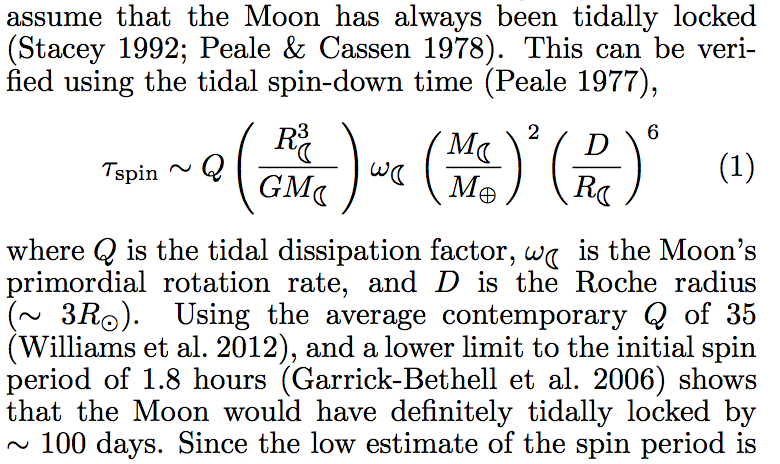Last time, I discussed the Lunar Farside Highlands Problem, and how I first got interested in it.
Back in 2011, Diana Valencia was giving our departmental colloquium when she mentioned as an aside CoRoT-7b, an apparently rocky planet so close to its parent star that its nearside is not just molten, but partly gaseous. The gasses form an atmosphere that blows around the planet and some minerals preferentially freeze out on the cold side, creating very different star-side and space-side minerals. Crazy!
Artist’s impression of CoRoT-7 b.
Anyway, I was wondering if the CoRoT-7b situation was at all analogous to the young Moon after the giant impact that formed it: after the giant impact, the Earth would have been hot — probably thousands of Kelvins — and the Moon would have only been a few Earth radii away. This is quite similar geometrically and thermodynamically to CoRoT-7b orbiting its parent star. Might the Earth have vaporized the Moon’s crust and caused it to redeposit on the farside?

Arpita Roy (right) is a Penn State grad student that has lately been working with Suvrath Mahadevan on the Habitable Zone Planet Finder, but she also does occasional work with me. She was responsible for the key insight that finally cracked the mystery of the MARVELS-1 system.
Arpita asked, shortly after Diana’s talk, about a possible 2nd year project, something short and not at all what she had been working on. I mentioned my idea, and she ran with it. I decided to ask Steinn Sigur�sson to help, since I had never written a theory paper before, and we needed a broad theorist to help with the tricky bits. With Steinn offering us the appropriately reckless encouragement to head off into a field we all had zero training in, Arpita started a self-directed crash course in lunar geology.
Penn State has very few people that would call themselves “planetary scientists”. Jim Kasting, who fills the role nicely but declines the title, patiently listened to my idea about the lunar highlands over lunch, and politely gave me a rough lay of the land about why he thought that wasn’t right. I wasn’t too dismayed, though — Jim wasn’t very familiar with the proposed solutions to the lunar highlands problem and I chose to interpret his politeness as gentle encouragement to learn more about the problem.

We enlisted the help of two other planetary types in the University Park penumbra. The first was Neyda Abreu (left) of Penn State DuBois, a meteoriticist who has a lab here on University Park campus. Neyda graciously met us over coffee several times to help us out with the geology details that we weren’t sure about, like the typical sequence of crust formation and how to pronounce geology words like “plagioclase”.
Once Arpita had come up to speed on the lunar geology jargon, she got to work answering some questions.
First: When did the Moon tidally lock? It seems naive to think that the side we see now was the side that formed facing us, but could it be true?

Answer: The tidal locking timescale goes as the sixth power of the distance between the Moon and Earth, so when it formed it was very strongly tidally damped. The would have lost an e-folding of rotational energy every 100 days or so, and since this less than the time it took to form, the moon essentially formed tidally locked. Unless a subsequent impact spun it up (or down) again, the Moon has always had the same side facing the Earth!
So, check off that box. The nearside might have a thinner crust because it’s the nearside, not vice versa.
Second: Would the Earth really keep the nearside that much warmer?

Answer: Yes, when the Moon was forming, the nearside cools slowly towards half the temperature of the Earth looming large in the sky (40 degrees across!), while the farside cools more quickly towards 250 K. Of course, the Moon does not necessarily reach these equilibrium temperatures, but because it has further to cool, the farside will cool faster. The hot Earth essentially insulates the nearside against radiative cooling.
Third: Can we get the crust to collect on the back somehow? This was much trickier. Over coffees, Lynn Carter of Goddard Space Flight Center, a bone fide lunar scientist and occasional visitor to State College, helped us a lot in sorting out the basics of how the Moon’s crust forms, what it is composed of, and what the Earth might have had to do with any of this.
Once we had a feel for what the literature did (and didn’t) say about the Moon’s formation, Arpita was able to quickly identify the primary problem with my original idea that the young Earth vaporized the nearside lunar crust, which doesn’t work at all. But that actually led us to a big insight…
More on that next time.
Parts of this post were written by Arpita Roy.


Fabulous, Jason and Arpita! :D
Hi! Very interesting idea about why near and far sides of Moon are so different. My question: How did the Moon get tidally locked so fast, without presence of oceans on Earth yet? Did the magma on early Earth take the place of the present ocean water in terms of tidal actions on both bodies? Thanks!
Rick in Oregon